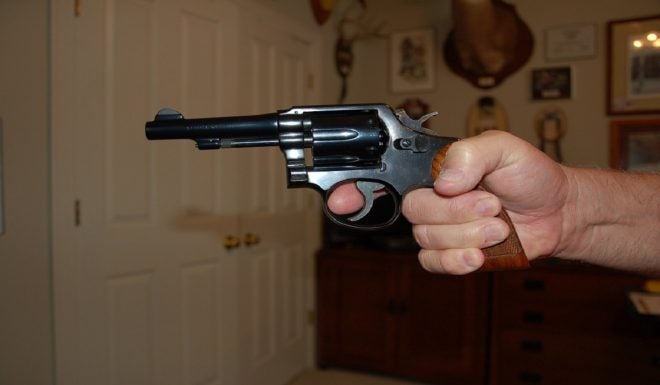The Smith Model 10: Everybody’s Handgun
Dr. John Woods 09.21.20

If ever there was a generic specimen of the classic double action revolver, the Smith and Wesson Model 10 and its lineage has to be it. This 38 Special wheel gun has seen action in militaries and law enforcement agencies all over the world since its inception in 1899. Literally tens of thousands of Model 10s reside in the possession of private citizens for everyday shooting uses including personal defense, home defense, and just fun recreational shooting.
The Smith 10 got its start as the 38 Military and Police. The handgun is based on the Smith proven K-frame, just slightly smaller than the mid-frame L series. These cylinder revolvers are 6-shot loading for the time honored mid-range powered 38 Special. Since 1899 these guns started out as 5-screw models, then 4, then 3. There have been literally dozens of modifications or enhancements to the Model 10 over the years.
As with most Smith revolvers after model numbers were assigned rather than model names, the yoke is stamped with the model number and version. They began with just the “10”, then 10-1 and so forth as modifications were made to the subsequent models. Today, though the Model 10 is only currently produced in the “Classic” line of Smith handguns, the latest 10-dash designation is at 10-13.
Smith 10s came in barrel lengths of 2-4-5-6 inches as factory standard and some 3-inch by special order only. The grip butts can be found in round or square configurations. The finishes are either deep Smith blue or nickel. Never quite got interested in a shiny, reflective gun, but each to his own.
“Sights” on a Model 10 consist of a plain ramp front or a rounded half-moon on the oldest models. The rear “sight” is more of a channel milled down the center of the top strap. It causes the eye, though, to point naturally down the barrel. After all, such a handgun is for up close work, not long distance shooting. It was meant for armies, police officers, and us.
The six-shot cylinder releases from the frame with a push forward slide checkered thumb button on the left side of the frame just below the hammer. Pushing this release forward moves the cylinder pin forward through the cylinder pushing a lock up spring loaded catch pin forward under the barrel. Then the cylinder can be swung out to the left to load or unload.
The unload part comes simply by pushing the cylinder pin backwards releasing the star ejector pulling out the cartridges empty or loaded by their rims. Everything is mechanical on a Smith revolver. There is very little to go foul as long as everything is kept reasonably clean and lubricated occasionally.
One of the more critical changes in the Smith 10 series came with version 10-11 when the classic old hammer pivoting and pinned firing pin was replaced with a hammer that strikes a flat face to hit a floating firing pin inside the rear of the frame. The old style firing pins did get brittle after maybe 50 years or so. I guess they decided to upgrade that component.
Rare chambers in the Model 10 included a trial at the 357 Magnum, but apparently they eventually opted to create the Model 19 to handle those. That model, too, is worthy of a separate study, frankly as are most Smith revolvers. The Model 10 was also chambered for the 32 H&R Magnum for a while, but I have never seen one. If you do, buy it.
Lineage of the Model 10 includes the original Military and Police versions running from 1899 to 1902. The post WWII but pre-Model 10s were manufactured from 1946 until 1957. Post WWII Model 10s were made from 1957 until 2010. Then the Model 10 was officially discontinued from the Smith and Wesson catalog. As mentioned, a run of Model 10s have been made in Smith’s new Classic line to reintroduce some of the old models they previously quit making.
When you grab up an old Smith revolver like a Model 10, the heft comes from steel. Unlike the largely polymer guns of today, heavy metal has a reassuring feel to the grip. Crank back that hammer slowly to enjoy the engagement of finely made and tuned internal action parts. Different from the sounds of cocking a single action cowboy six gun, the double action revolver emits a sound of its own. It’s reassuring. Or just pull the trigger double action instead.
The Smith Model 10 is far from a fancy revolver. That’s the point. It is a utilitarian handgun that virtually anybody can learn to shoot well. That is probably to a great extent why these revolvers were and are so popular. The good part is, too, that you cannot walk through a gun show without seeing several examples for sale at fairly reasonable prices. They are fun to study and collect. Get one for yourself and start some shooting fun.